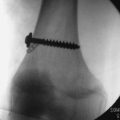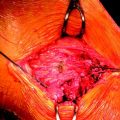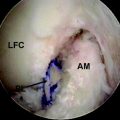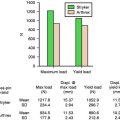Chapter 71 Allograft Complications and Risk Factors
Introduction
Allograft use has been increasing because donor site morbidity is avoided. Although this benefit is well understood, the drawbacks are more complicated and less well understood. The purpose of this chapter is to collect information on potential allograft risk and allograft complications to help surgeons in their risk-benefit analyses. Some of the information contained in this chapter can be found elsewhere in the chapters on stability results (see Chapter 69) and infections (see Chapter 70). Potential allograft complications/risks can be divided into three categories: (1) graft failure or increased laxity and late graft laxity; (2) infection; and (3) disease transmission. The first two also occur with autografts; the third is allograft specific. Potential causes for increased allograft laxity are: (1) radiation sterilization; (2) nonradiation sterilization; (3) freezing; (4) increased donor age; and (5) increased allograft shelf life. Potential causes for increased allograft infection and disease transmission risk are: (1) failure to follow tissue-handling guidelines; (2) fraudulent procurement practices; (3) lack of sterilization; (4) foreign body effects; and (5) harvest/preparation contamination.These are summarized in Box 71-1. It is of interest to note that two of these factors involve human error by individuals not within the surgeon’s control. This highlights the inherently increased risk in allografts versus autografts attendant to the fact that so many delicate and exacting tasks must be properly performed before the graft gets to the operatingroom. Most tissue banks are run meticulously and with great care. However, human error, or intentional human misbehavior, can occur with the surgeon unaware.
Areas of Morbidity
Graft Failure and Laxity
The meta-analytic data presented in Chapter 69 showed allografts to have a failure rate two to three times that of autografts, even when radiated grafts were removed from consideration. It also showed the allograft normal stability rate to be significantly lower. This effect occurred in both bone–patellar tendon–bone (BPTB) and soft tissue grafts. This material is covered in more detail in that chapter. Despite these overall worse stability results, it should be pointed out that some reports show excellent allograft stability rates.1
Delayed Graft Failure
There is some evidence that allografts have a tendency toward late failure,2–4 whereas autografts have shown very little tendency to late failure.5 This perhaps mirrors the experience with bone allografts, which can fracture years after clinical implantation. This late failure has been accompanied by biopsy evidence of late or absent recellularization,2,3,6 which may be causally related. It may be that allograft-implanted patients should be counseled that late failure can occur. A longer period of follow-up for allograft patients may be indicated than is necessary with autografts.
Infection
It is not clear whether the overall infection rate is higher for allografts than for autografts, but there is evidence that it may be so. The Centers for Disease Control and Prevention (CDC), in a well-known analysis of one surgicenter’s experience, showed no infections in autografts and sterilized allografts but a 3% infection rate7 in unsterilized allografts. In our clinical experience the only infected anterior cruciate ligament reconstruction (ACLR) failures we have seen have been in allografts. We have seen one patient with two infected allografts from two different tissue banks operated at two different hospitals by different surgeons for each procedure. This patient went on to autograft revision without incident.
Disease Transmission
The rate of disease transmission risk is difficult to evaluate because routine viral testing of post-allograft patients is not carried out, although it is certainly very low. A recent report, however, included a patient who had hepatitis B transmitted from a donor who initially tested negative for hepatitis B and whose allograft was radiated. After the recipient contracted hepatitis, repeated, more sophisticated testing showed that that the donor was indeed the source of the hepatitis virus.8 Studies would indicate that the current sub–3Mrad levels of radiation now most often employed would be expected to kill neither the hepatitis nor human immunodeficiency viruses.9,10 Higher levels in the 5Mrad range are probably necessary. Newer protocols using such higher doses with radioprotectant may provide the answer.11
Potential Causes of Increased Laxity
Radiation Sterilization
Radiation has been clearly shown to weaken grafts.12–20 Newer protocols are intended to mitigate or eliminate this effect, but 2-year follow-up data are currently lacking.
Chemical Treatments
Non-radiation cleaning (e.g., Allowash, Lifenet, Virginia Beach, VA), sterilization (e.g., Biocleanse, Lifenet),21 cryoprotectant,22 radioprotectant (e.g., Clearant, Los Angeles, CA), tutoplasty, ethylene oxide, and other techniques are used on allografts. The more aggressive these procedures, the more they affect the material properties of the graft. In one recent study the mechanical properties of the grafts were substantially altered by a cryoprotectant technique such that the surgeon was unable to use the graft.22 Questions about these grafts can only partially be answered by studies that analyze strength at time zero. It is the response of the graft to cellular and vascular ingrowth and ligamentization that determines ultimate strength. The effects of such treatments on this process have been little studied.
Freezing
Most grafts are frozen and rethawed at least twice. Grafts are initially frozen after procurement pending the results of cultures. Typically they are then thawed and prepared and then refrozen while a recipient is identified. Freezing has been shown to adversely affect tissue properties.23 Cryoprotectants are used to protect grafts from the deleterious effects of freezing, but it is unknown how well they work. The temperature of freezing also plays a role. Thus it is reasonable to wonder how much a single cycle of freezing may alter the graft or the subsequent ligamentization remodeling process. Further complicating this issue is the fact that some grafts are only frozen, whereas some are freeze-dried or lyophilized. It is unknown whether the addition of drying to freezing is a benefit because it removes potentially damaging ice crystals, is of no consequence, or is deleterious because it further modifies the tissue.
Increased Donor Age
Kurzweil8 found a strong trend toward greater laxity with increased donor age in patients undergoing tendo–Achilles ACLR. Criteria for donor age vary widely, and no standard criteria exist for upper age limit.
Potential Causes of Infection and Disease Transmission
Fraudulent Tissue Procurement of Unsuitable Tissue
Dubbed the “Frankenstein” or “body snatching” scandal by the media, this highly publicized 2005 episode involved procurement of nonsterile, aged, and often diseased body parts from funeral homes that were then represented as having been taken under sterile conditions from hospitals. A significant number of ACL grafts were implanted. Debates and lawsuits are now in process over what complications are attributable to these grafts. With government inspections having fallen from one in three tissue companies annually in 2001 to one in eight in 2006 as the number of companies has increased from 406 to 2030,27 the possibility of undetected problems is very real. The surgeon must thus be familiar not only with the tissue bank but also with its graft feeder sources.
Lack of Sterilization
It is believed by many (see Chapter 70) that sterile procurement by itself is inadequate to guard against disease transmission.
Conclusions
1 Bach BRJr, Aadalen KJ, Dennis MG, et al. Primary anterior cruciate ligament reconstruction using fresh-frozen, nonirradiated patellar tendon allograft: minimum 2-yeasr follow-up. Am J Sports Med. 2005;33:284-292.
2 Prodromos CC, Fu F, Howell S, et al. Controversies in soft tissue ACL reconstruction. Presented at symposium at the 2006 meeting of the American Academy of Orthopaedic Surgeons, Chicago, March, 2006. 2006.
3 Siegel MG. Personal communication. May, 2006.
4 Risinger RJ, Bach BRJr. Late anterior cruciate ligament reconstruction failure by femoral bone plug dislodgement. J Knee Surg. 2006;19:202-205.
5 Prodromos CC, Han YS, Keller BL, et al. Stability of hamstring anterior cruciate ligament reconstruction at two- to eight-year follow-up. Arthroscopy. 2005;21:138-146.
6 Scheffler S, Unterhauser F, Keil J, et al. Comparison of tendon-to-bone healing after soft tissue autograft and allograft ACL reconstruction in a sheep model. Presented at the 2006 meeting of the European Society of Sports Traumatology, Knee Surgery, and Arthroscopy, Innsbruck, Austria. May, 2006.
7 Crawford C, Kainer M, Jernigan D, et al. Investigation of postoperative allograft-associated infections in patients who underwent musculoskeletal allograft implantation. Clin Infect Dis. 2005;41:195-200.
8 Grafe MW, Kurzweil PR. ACL reconstruction with Achilles tendon allografts in revisions and patients over 30. Presented at the 2005 meeting of the Arthroscopy Association of North America, Vancouver, BC, Canada, May, 2005. 2005.
9 Fideler BM, Vangsness CTJr, Moore T, et al. Effects of gamma irradiation on the human immunodeficiency virus. J Bone Joint Surg. 1994;76A:1032-1035.
10 Tomford WW. Transmission of disease through transplantation of musculoskeletal allografts. J Bone Joint Surg. 1995;77A:1742-1754.
11 Forng RY, Willkommen H, Almeida J, et al. Terminal sterilization of human tissue allografts: application of high-dose gamma irradiation using the clearant process. Unpublished data
12 Smith CW, Young IS, Kearney JN. Mechanical properties of tendons: changes with sterilization and preservation. J Biomed Eng. 1996;118:56-61.
13 Maeda A, Inoue M, Shino K, et al. Effects of solvent preservation with or without gamma irradiation on the material properties of canine tendon allografts. J Orthop Res. 1993;11:181-189.
14 Maeda A, Horibe S, Matsumoto N, et al. Solvent-dried and gamma-irradiated tendon allografts in rats. J Bone Joint Surg. 1998;80B:731-736.
15 Goertzen MJ, Clahsen H, Burrig KR, et al. Sterilisation of canine anterior cruciate allografts by gamma irradiation in argon. J Bone Joint Surg. 1995;77B:205-212.
16 Curran AR, Adams DJ, Gill JL, et al. The biomechanical effects of low-dose irradiation on bone-patellar tendon-bone allografts. Am J Sports Med. 2004;32:1131-1135.
17 Gibbons MJ, Butler DL, Grood ES, et al. Effects of gamma irradiation on the initial mechanical and material properties of goat bone-patellar tendon-bone allografts. J Orthop Res. 1991;9:209-218.
18 Salehpour A, Butler DL, Proch FS, et al. Dose-dependent response of gamma irradiation on mechanical properties and related biochemical composition of goat bone-patellar tendon-bone allografts. J Orthop Res. 1995;13:898-906.
19 Toritsuka Y, Shino K, Horibe S, et al. Effect of freeze-drying or gamma irradiation on remodeling of tendon allograft in a rat model. J Orthop Res. 1997;15:294-300.
20 Hamer AJ, Stockley I, Elson RA. Changes in allograft bone irradiated at different temperatures. J Bone Joint Surg. 1999;81B:342-344.
21 Mroz TE, Lin EL, Summit MC, et al. Biomechanical analysis of allograft bone treated with a novel sterilization process. Spine J. 2006;6:34-39.
22 Caborn D, Nyland J, Chang HC, et al. Tendon allograft cryoprotectant incubation and rehydration time alters mechanical stiffness properties. Presented at the 2006 meeting of the European Society of Sports Traumatology, Knee Surgery, and Arthroscopy, Innsbruck, Austria. May, 2006.
23 Clavert P, Kempf JF, Bonnomet F, et al. Effects of freezing/thawing on the biomechanical properties of human tendons. Surg Radiol Anat. 2001;23:259-262.
24 Sterling JC, Meyers MC, Calvo RD. Allograft failure in cruciate ligament reconstruction: follow-up evaluation of eighteen patients. Am J Sports Med. 1995;23:173-178.
25 Arnoczky SP, Warren RF, Ashlock MA. Replacement of the anterior cruciate ligament using a patellar tendon allograft: an experimental study. J Bone Joint Surg. 1986;68:376-385.
26 Schulte K, Thompson W, Jamison J, et al. The immune response to allograft anterior cruciate ligament reconstruction: clinical correlation. Presented at the 1996 meeting of the American Academy of Orthopaedic Surgeons, February 1996, Atlanta. 1996.
27 Hays T. Profit began before the grave in Frankenstein case. Chicago Sun Times. June 12, 2006;27. Available online at www.suntimes.com/output/news/cst-nws-flesh12.html







